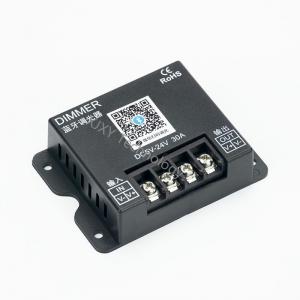
Add to Cart
Bluetooth LED Dimmer DC12-24V LED Module Wall Light Box PWM LED Driver Dimmer
Bluetooth LED Driver Dimmer DC12-24V LED strips light box wall light PWM control LED dimmer.
Quick Detail:
Description:
This single LED dimmer adopt advanced PWM control technology, used to control a variety of constant voltage LED single lamp, adopt knob to control the dimmer.
Our LED dimmer have hand operation type, remote control type, Bluetooth type, Rainproof type.
LED dimmers work in three ways
1. Pulse Width Modulation (PWM) digitizes the power square wave and controls the duty cycle of the square wave, so as to achieve the purpose of controlling the current.
2. Constant current power supply control with analog linear technology can easily adjust the current size.
3. Grouping regulation Group multiple leds with a simple grouping device.

Specifications:
| Series | Name | LED dimmer |
| 1 | Basic info | DC12-24V |
| 2 | Model | DH-1224-3 |
| 3 | Material | Plastic |
| 4 | Rated input | DC12-24V |
| 5 | Max load current | 30A |
| 6 | Grade | IP20 |
| 7 | Working temperature | 20℃-70℃ |
| 8 | Dimension | 8.5*6.2*2.0CM |
| 9 | Weight | 100g |
Demonstration:

Warning:
1. Please confirm the power is correct.
2. Never connect two wires directly in case of short circuit.
3. Please confirm the lead wire is correct.
4. Warranty of this product is one year ,but exclude the artificial situation of damaged or overload working.
DC12-24V LED dimmer related models list:
| Model | Input Voltage | Max Load | Feature |
| DH-1224-1 | 12-24V | 30A | Hand operation |
| DR-1224-2 | 12-24V | 30A | Remote control operation |
| DM-1224-3 | 12-24V | 30A | Mobile Bluetooth |
| DW-1224-4 | 12-24V | 30A | Rainproof hand operation |
| DW-R-1224-5 | 12-24V | 30A | Rainproof remote control |
Applications:
DC12-24V LED Dimmer is mainly used in LED strips, LED module, light box, light line, wall light, room light with max 30A.


FAQ
1. How many kinds of led dimmer you produce?
A: Up to now, there are four kinds of led dimmers: hand operation type, Bluetooth type, remote control type, rainproof type.
2. Can I place a sample order?
A: Yes, sample order is available after full test and before delivery.
3. What about the lead time?
A: 3-5 days for Sample, 8-12 working days for mass production.
4. What is MOQ for led driver?
A: MOQ usually is 500pcs except sample order.
5. How do you ship the goods and how long does it take to arrive?
A: We ship by sea, by railway or by air. If samples, always by express such as FEDEX or DHL etc. It all depends.
7. How about the payment terms?
A: T/T is our main payment terms.
8. How to start an order with each other?
A: Know your true requirements or application fully, quote based on your requirements and our suggestion, confirms the samples and places deposit for formal order and we arrange the mass production.
9. OEM and ODM is acceptable?
A: Yes. OEM or ODM is acceptable.
10: Do you offer warranty period for the products as a part of after sale service?
A: Yes, we offer 1 year warranty for our products after delivery.
About LED Dimmer
Whether LED is driven by buck, boost, buck/boost, or linear regulator, the most common thread connecting each driver circuit is the need to control the light output. Only a few applications today require the simple function of turning on and off, and the vast majority requires tuning the luminosity from 0 to 100%. For photometric control, the two main solutions are to adjust the LED current linearly (analog dimming) or to switch the driving current back and forth from 0 to the target current value (digital dimming) at undetectable high frequencies. Using pulse WIDTH MODULATION (PWM) to set the cycle and operating period IS probably the simplest way to achieve digital dimming, BECAUSE the same technology can be used to control most switching converters.
Dimmer, an electrical device that changes the light flux of a light source in a lighting device, adjusts the level of illumination. The purpose of a dimmer is to adjust the light to different levels. By reducing or increasing the RMS voltage to promote the average power of the light produced by different intensity of light output. This regulation is intended to control lighting, although variable voltage devices can be used for a variety of purposes.